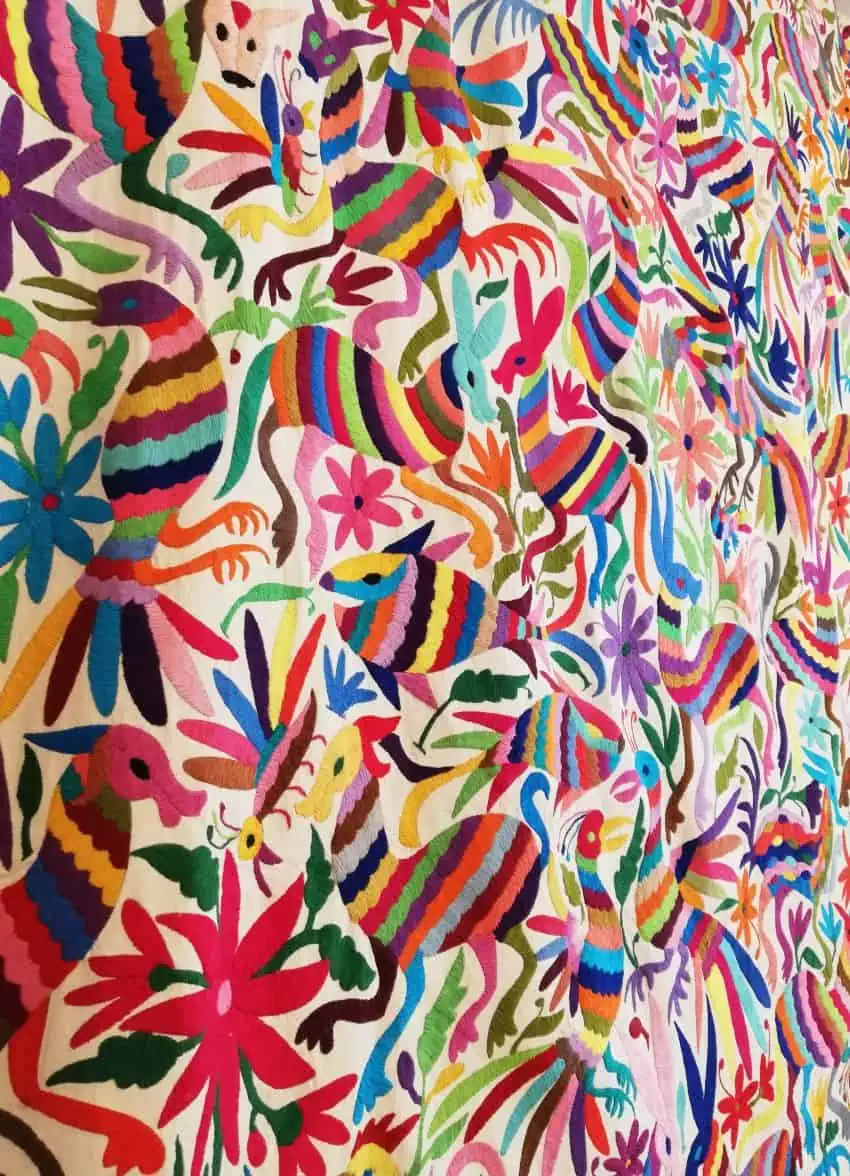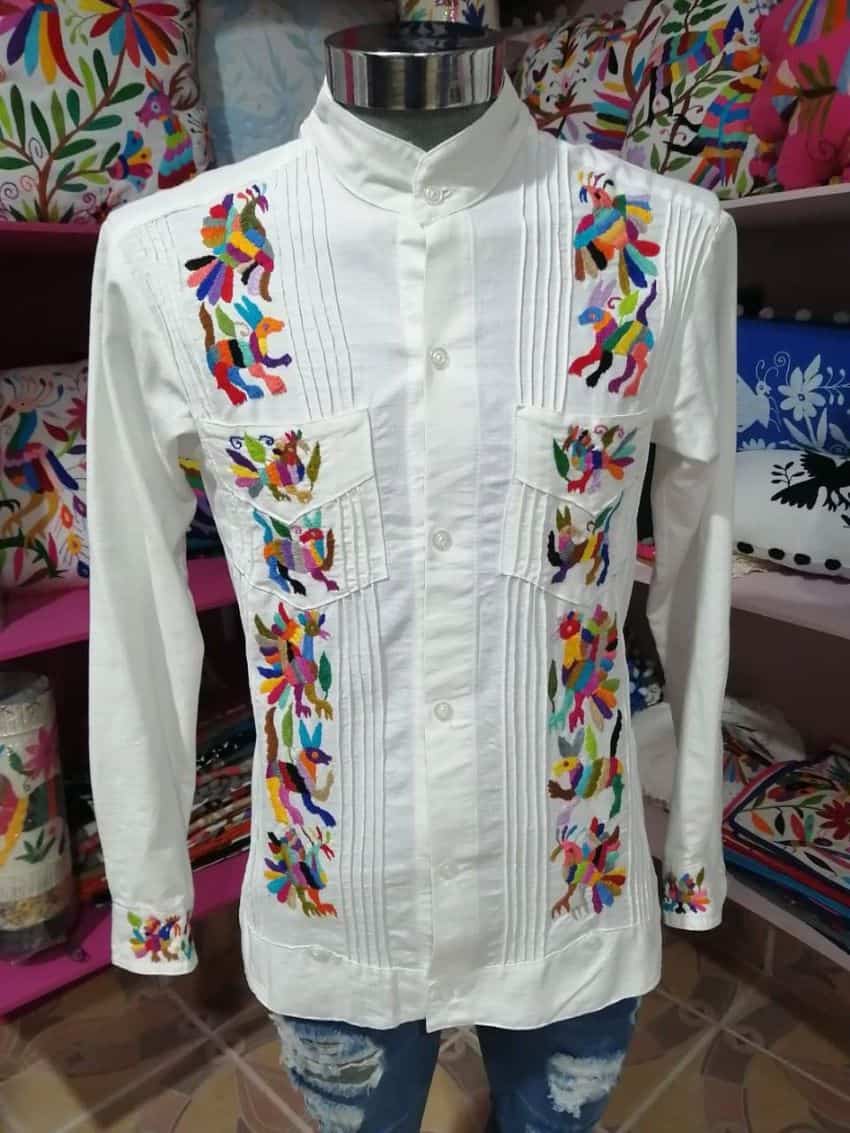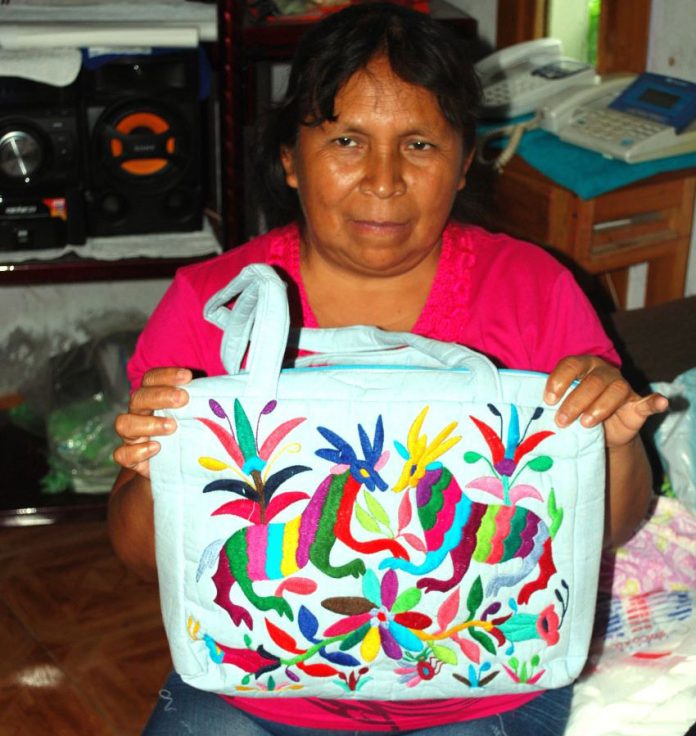As a newbie to Mexico on one of my first trips to Oaxaca I was captivated by huge swaths of cloth almost entirely covered in embroidery. Having been a quilter, I know the time and torn-up fingertips necessary to do this kind of needlework.
This was how I met Tenango embroidery for the first time.
At first, I assumed that this cloth I saw was from Oaxaca, given the location of the market and the state’s reputation for handcrafts. Actually, Tenango embroidery isn’t from Oaxaca at all but from a small region on the Hidalgo-Puebla border, home to an Otomí (or hñuhñu) community largely unknown to the rest of Mexico and completely unknown to the world.
Tenango folk art is named after Tenango de Doria, a municipality in Hidalgo right on the border with Puebla. Otomí artisans practicing this craft can be found further afield in both states, especially in Pahuatlán, a municipality in northwest Puebla. While some artisans make and embroider ready-to-use items like shirts, bags or tablecloths, others simply embroider raw cloth for sale.
This region is part of the Sierra Madre Oriental, a rugged mountainous area that receives significant rainfall because of its proximity to the Gulf of Mexico. The area has lush vegetation, images of which dominate Tenango embroidery, distinguishing it from other Otomí styles.

Travel in the region is difficult, with roads on steep mountainsides often getting washed out, but the isolation the terrain provided helped protect Otomí heritage over the centuries. Many people here still speak Otomí, and several pre-Hispanic religious beliefs survive.
However, the tradeoff has been grinding poverty.
The Otomí are one of Mexico’s larger indigenous communities, but because of their history, they are scattered in communities in eight states and Mexico City. There are cultural differences among Otomí groups, with Tenango embroidery done only in eastern Mexico.
Tenango is a modified embroidery style, simplified from what had been done here for centuries. According to most histories, drought decimated the subsistence agriculture of the area in the 1960s, and locals needed a new form of income to survive.
The original idea was to make the traditional blouses with pepanado embroidery, a style done with little running stitches, but they are too time-consuming and would drive the price too high. So embroidery floss is instead drawn back and forth over the area to be colored in, with almost all the floss on the visible side.
For large figures, stitches are arranged in stripe-like patterns, using one or multiple colors. Design elements are highly stylized — static flora and fauna inspired by both domestic and wild plants and animals such as chickens, dogs, wild birds, rabbits, turtles, flowers and trees. Rarely do people and houses appear. The figures are not meant to be realistic and are often done in bright colors such as yellows, greens, reds and blues.

This, like all embroidery work, is traditionally the purview of women, with mothers teaching daughters, but Tenango’s economic success means that a few men have picked it up as well. Although the style is less involved than pepanado, it is still time-consuming. A good bedspread can take up to six years to make.
Unfortunately, such embroidery does not bring in very much money. The worst off must rely on selling to traveling middlemen who sometimes obtain pieces only by bartering food. Some embroiderers can do better because they bought sewing machines. This allows them to create finished products such as clothing items, napkins and tablecloths, which fetch better prices than embroidery on cloth alone.
Although the designs have not changed much since the 1960s, the range of products it is found on has widened, now including many modern clothing items and even footwear. Traditional and nontraditional products can be found for sale in most parts of Mexico, especially in tourist areas — everywhere from street markets to luxury shops.
Although considered traditional, state and local authorities have attributed Tenango embroidery to a woman named Josefina José Tavera, who lived in the community of San Nicolás near Tenango and died in May. According to her family, she invented it because in 1960 she was a single mother who needed money to care for her children. She drew the animals and plants around her, embroidered them and began selling in Pahuatlán.
Since it was never registered with trademark authorities, it is folk art under Mexican law. Foreign designers such as Carolina Herrera and Hermès have used the designs in some of their product lines, with controversies arising as late as 2019. Such issues with Mexican crafts, especially those done by indigenous groups, prompted the Mexican government to change the law to require those using such designs to identify them as such. However, these laws only apply to Mexico.
There are a few Otomí artisans and businesses that have worked to take advantage of interest in these designs, including on modern clothing and home items. One of these is Tonani Lirio de los Valles.
The business is in the regional commercial city of Tulancingo, Hidalgo, but the family that runs it is from the Tenango region. They design clothing and home items and work with up to around 100 embroiderers from their home region when business is good. They have a Facebook page and are listed with the prestigious Feria Maestros del Arte in Chapala, Jalisco.
One artisan who does the embroidery style on more traditional objects is Inocencio Pérez Iturbide. His fine work has caught the attention of the prestigious Feria and is included in their online catalogue.
One unusual fusion of local crafts is wall hangings that combine embroidered panels with locally made amate bark paper. Work of this kind is made by artisans such as Leobardo Espíritu Rocha and worth a look.
Leigh Thelmadatter arrived in Mexico 17 years ago and fell in love with the land and the culture. She publishes a blog called Creative Hands of Mexico and her first book, Mexican Cartonería: Paper, Paste and Fiesta, was published last year. Her culture blog appears regularly on Mexico News Daily.
